Σαντορίνη
( Santorini )Santorini (Greek: Σαντορίνη, romanized: Santoríni, pronounced [sa(n)doˈrini]), officially Thira (Greek: Θήρα, romanized: Thíra, Greek pronunciation: [ˈθira]) and Classical Greek Thera (English pronunciation ), is an island in the southern Aegean Sea, about 200 km (120 mi) southeast from the Greek mainland. It is the largest island of a small circular archipelago, which bears the same name and is the remnant of a caldera. It is the southernmost member of the Cyclades group of is...Read more
Santorini (Greek: Σαντορίνη, romanized: Santoríni, pronounced [sa(n)doˈrini]), officially Thira (Greek: Θήρα, romanized: Thíra, Greek pronunciation: [ˈθira]) and Classical Greek Thera (English pronunciation ), is an island in the southern Aegean Sea, about 200 km (120 mi) southeast from the Greek mainland. It is the largest island of a small circular archipelago, which bears the same name and is the remnant of a caldera. It is the southernmost member of the Cyclades group of islands, with an area of approximately 73 km2 (28 sq mi) and a 2011 census population of 15,550. The municipality of Santorini includes the inhabited islands of Santorini and Therasia, as well as the uninhabited islands of Nea Kameni, Palaia Kameni, Aspronisi and Christiana. The total land area is 90.623 km2 (34.990 sq mi). Santorini is part of the Thira regional unit.
The island was the site of one of the largest volcanic eruptions in recorded history: the Minoan eruption (sometimes called the Thera eruption), which occurred about 3,600 years ago at the height of the Minoan civilization. The eruption left a large caldera surrounded by volcanic ash deposits hundreds of metres deep.
It is the most active volcanic centre in the South Aegean Volcanic Arc, though what remains today is chiefly a water-filled caldera. The volcanic arc is approximately 500 km (300 mi) long and 20 to 40 km (12 to 25 mi) wide. The region first became volcanically active around 3–4 million years ago, though volcanism on Thera began around 2 million years ago with the extrusion of dacitic lavas from vents around Akrotiri.
 Springtime landscape in a Fresco from the Bronze Age, Akrotiri
Springtime landscape in a Fresco from the Bronze Age, Akrotiri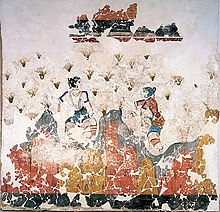 The "saffron-gatherers"
The "saffron-gatherers"Excavations starting in 1967 at the Akrotiri site under the late Professor Spyridon Marinatos have made Thera the best-known Minoan site outside Crete, homeland of the culture. The island was not known as Thera at this time. Only the southern tip of a large town has been uncovered, yet it has revealed complexes of multi-level buildings, streets, and squares with remains of walls standing as high as eight metres, all entombed in the solidified ash of the famous eruption of Thera. The site was not a palace-complex as found in Crete nor was it a conglomeration of merchant warehousing. Its excellent masonry and fine wall-paintings reveal a complex community. A loom-workshop suggests organized textile weaving for export. This Bronze Age civilization thrived between 3000 and 2000 BC, reaching its peak in the period between 2000 and 1630 BC.[1]
Many of the houses in Akrotiri are major structures, some of them three storeys high. Its streets, squares, and walls were preserved in the layers of ejecta, sometimes as tall as eight metres, indicating this was a major town. In many houses stone staircases are still intact, and they contain huge ceramic storage jars (pithoi), mills, and pottery. Noted archaeological remains found in Akrotiri are wall paintings or frescoes that have kept their original colour well, as they were preserved under many metres of volcanic ash. Judging from the fine artwork, its citizens were sophisticated and relatively wealthy people. Among more complete frescoes found in one house are two antelopes painted with a confident calligraphic line, a man holding fish strung by their gills, a flotilla of pleasure boats that are accompanied by leaping dolphins, and a scene of women sitting in the shade of light canopies. Fragmentary wall-paintings found at one site are Minoan frescoes that depict "Saffron-gatherers" offering crocus-stamens to a seated woman, perhaps a goddess important to the Akrotiri culture. The themes of the Akrotiri frescoes show no relationship to the typical content of the Classical Greek décor of 510 BC to 323 BC that depict the Greek pantheon deities.
The town also had a highly developed drainage system. Pipes with running water and water closets found at Akrotiri are the oldest such utilities discovered.[2] The pipes run in twin systems, indicating that Therans used both hot and cold water supplies. The origin of the hot water they circulated in the town probably was geothermic, given the volcano's proximity.
The well preserved ruins of the ancient town are often compared to the spectacular ruins at Pompeii in Italy. The canopy covering the ruins collapsed in an accident in September 2005, killing one tourist and injuring seven more. The site was closed for almost seven years while a new canopy was built. The site was re-opened in April 2012.
The oldest signs of human settlement are Late Neolithic (4th millennium BC or earlier), but c. 2000–1650 BC Akrotiri developed into one of the Aegean's major Bronze Age ports, with recovered objects that came not just from Crete, but also from Anatolia, Cyprus, Syria, and Egypt, as well as from the Dodecanese and the Greek mainland.
Dating of the Bronze Age eruption Stoa Basilica of ancient Thera
Stoa Basilica of ancient Thera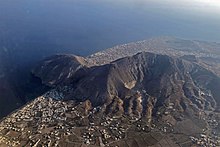 Aerial view of the island of Santorini with detail of Profitis Ilias (Santorini) and the ruins of ancient Thera (on the promontory on the left)
Aerial view of the island of Santorini with detail of Profitis Ilias (Santorini) and the ruins of ancient Thera (on the promontory on the left)The Minoan eruption provides a fixed point for the chronology of the second millennium BC in the Aegean, because evidence of the eruption occurs throughout the region and the site itself contains material culture from outside. The eruption occurred during the "Late Minoan IA" period of Minoan chronology at Crete and the "Late Cycladic I" period in the surrounding islands.
Archaeological evidence, based on the established chronology of Bronze Age Mediterranean cultures, dates the eruption to around 1500 BC.[3] These dates, however, conflict with radiocarbon dating which indicates that the eruption occurred at about 1645–1600 BC.[4] For those, and other reasons, the date of the eruption is disputed.
Ancient period Picture of a young girl of Santorini, Cultural Center Megaro Gyzi, Fira
Picture of a young girl of Santorini, Cultural Center Megaro Gyzi, Fira Skaros Rock, originally the location of medieval fortifications
Skaros Rock, originally the location of medieval fortifications The Byzantine Church of Panagia Episkopi
The Byzantine Church of Panagia Episkopi Pyrgos Kallistis village
Pyrgos Kallistis village Presentation of the Theotokos church, Pyrgos village
Presentation of the Theotokos church, Pyrgos villageSantorini remained unoccupied throughout the rest of the Bronze Age, during which time the Greeks took over Crete. At Knossos, in a LMIIIA context (14th century BC), seven Linear B texts while calling upon "all the deities" make sure to grant primacy to an elsewhere-unattested entity called qe-ra-si-ja and, once, qe-ra-si-jo. If the endings -ia[s] and -ios represent an ethnic suffix, then this means "The One From Qeras[os]". If the initial consonant were aspirated, then *Qhera- would have become "Thera-" in later Greek. "Therasia" and its ethnikon "Therasios" are both attested in later Greek; and, since -sos was itself a genitive suffix in the Aegean Sprachbund, *Qeras[os] could also shrink to *Qera. If qe-ra-si-ja was an ethnikon first, then in following the entity the Cretans also feared whence it came.[5]
Probably after what is called the Bronze Age collapse, Phoenicians founded a site on Thera. Herodotus reports that they called the island Callista and lived on it for eight generations.[6] In the ninth century BC, Dorians founded the main Hellenic city on Mesa Vouno, 396 m (1,299 ft) above sea level. This group later claimed that they had named the city and the island after their leader, Theras. Today, that city is referred to as Ancient Thera.
In his Argonautica, written in Hellenistic Egypt in the third century BC, Apollonius Rhodius includes an origin and sovereignty myth of Thera being given by Triton in Libya to the Greek Argonaut Euphemus, son of Poseidon, in the form of a clod of dirt. After carrying the dirt next to his heart for several days, Euphemus dreamt that he nursed the dirt with milk from his breast, and that the dirt turned into a beautiful woman with whom he had sex. The woman then told him that she was a daughter of Triton named Calliste, and that when he threw the dirt into the sea it would grow into an island for his descendants to live on. The poem goes on to claim that the island was named Thera after Euphemus' descendant Theras, son of Autesion, the leader of a group of refugee settlers from Lemnos.
The Dorians have left a number of inscriptions incised in stone, in the vicinity of the temple of Apollo, attesting to pederastic relations between the authors and their lovers (eromenoi). These inscriptions, found by Friedrich Hiller von Gaertringen, have been thought by some archaeologists to be of a ritual, celebratory nature, because of their large size, careful construction and – in some cases – execution by craftsmen other than the authors. According to Herodotus,[7] following a drought of seven years, Thera sent out colonists who founded a number of cities in northern Africa, including Cyrene. In the fifth century BC, Dorian Thera did not join the Delian League with Athens; and during the Peloponnesian War, Thera sided with Dorian Sparta, against Athens. The Athenians took the island during the war, but lost it again after the Battle of Aegospotami. During the Hellenistic period, the island was a major naval base for Ptolemaic Egypt.
Medieval and Ottoman period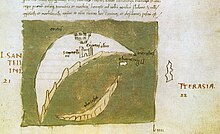 Medieval map of Santorini by Cristoforo Buondelmonti
Medieval map of Santorini by Cristoforo BuondelmontiAs with other Greek territories, Thera then was ruled by the Romans. When the Roman Empire was divided, the island passed to the eastern side of the Empire which today is known as the Byzantine Empire.[8] According to George Cedrenus, the volcano erupted again in the summer of 727, the tenth year of the reign of Leo III the Isaurian.[9] He writes: "In the same year, in the summer, a vapour like an oven's fire boiled up for days out of the middle of the islands of Thera and Therasia from the depths of the sea, and the whole place burned like fire, little by little thickening and turning to stone, and the air seemed to be a fiery torch." This terrifying explosion was interpreted as a divine omen against the worship of religious icons[10][11] and gave the Emperor Leo III the Isaurian the justification he needed to begin implementing his Iconoclasm policy.
The name "Santorini" first appears c. 1153-1154 in the work of the Muslim geographer al-Idrisi, as "Santurin", from the island's patron saint, Saint Irene.[12] After the Fourth Crusade, it was occupied by the Duchy of Naxos which held it up to circa 1280 when it was reconquered by Licario (the claims of earlier historians that the island had been held by Jacopo I Barozzi and his son as a fief have been refuted in the second half of the twentieth century);[13][14][15] it was again reconquered from the Byzantines circa 1301 by Iacopo II Barozzi, a member of the Cretan branch of the Venetian Barozzi family, whose descendant held it until it was annexed in c. 1335 by Niccolo Sanudo after various legal and military conflicts.[16] In 1318–1331 and 1345–1360 it was raided by the Turkish principalities of Menteshe and Aydın, but did not suffer much damage.[12] Because of the Venetians the island became home to a sizable Catholic community and is still the seat of a Catholic bishopric.
From the 15th century on, the suzerainty of the Republic of Venice over the island was recognized in a series of treaties by the Ottoman Empire, but this did not stop Ottoman raids, until it was captured by the Ottoman admiral Piyale Pasha in 1576, as part of a process of annexation of most remaining Latin possessions in the Aegean.[12] It became part of the semi-autonomous domain of the Sultan's Jewish favourite, Joseph Nasi. Santorini retained its privileged position in the 17th century, but suffered in turn from Venetian raids during the frequent Ottoman–Venetian wars of the period, even though there were no Muslims on the island.[12]
Santorini was captured briefly by the Russians under Alexey Orlov during the Russo-Turkish War of 1768–1774, but returned to Ottoman control after.
19th centuryIn 1807, the islanders were forced by the Sublime Porte to send 50 sailors to Mykonos to serve in the Ottoman navy.[17]
In 1810, Santorini with 32 ships possessed the seventh largest of the Greek fleet after Kefallinia (118), Hydra (120), Psara (60), Ithaca (38) Spetsai (60) and Skopelos (35).[18]
During the last years of Ottoman rule, the majority of residents were farmers and seafarers who exported their abundant produce, while the level of education was improving on the island, with the Monastery of Profitis Ilias being one of the most important monastic centres in the Cyclades.[17]
In 1821 the island was home to 13,235 inhabitants, which within a year had risen to 15,428.[19]
Greek War of IndependenceAs part of its plans to foment a revolt against the Ottoman Empire and gain Greek Independence, Alexandros Ypsilantis, the head of the Filiki Eteria in early 1821, dispatched Dimitrios Themelis from Patmos and Evangelis Matzarakis (–1824), a sea captain from Kefalonia who had Santorini connections to establish a network of supporter in the Cyclades.[20] As his authority,[clarification needed] Matzarakis had a letter from Ypsilantis (dated 29 December 1820) addressed to the notables of Santorini and the Orthodox metropolitan bishop Zacharias Kyriakos (served 1814–1842). At the time, the population of Santorini was divided between those who supported independence, and (particularly among the Catholics and non-Orthodox) those who were ambivalent or distrustful of a revolt being directed by Hydra and Spetses or were fearful of the Sultan's revenge. While the island didn't come out in direct support of the revolt, they did send 100 barrels of wine to the Greek fleet as well in April 1821,[clarify] 71 sailors, a priest and the presbyter Nikolaos Dekazas, to serve on the Spetsiote fleet.[17]
Because of the lack of majority support for direct participation in the revolt, it was necessary for Matzarakis to enlist the aid of Kefalonians living in Santorini to, on 5 May 1821[17] (the feast day of the patron saint of the island), raise the flag of the revolution and then expel the Ottoman officials from the island.[20] The Provisional Administration of Greece organized the Aegean islands into six provinces, one of which was Santorini and appointed Matzarakis its governor in April 1822.[21][22] While he was able to raise a large amount of money (double that collected on Naxos), he was soon found to lack the diplomatic skills needed to convince the islanders who had enjoyed considerable autonomy to now accept direction from a central authority and contribute tax revenue to it. He claimed to his superiors that the islanders needed "political re-education" as they did not understand why they had to pay higher taxes than those levied under the Ottomans in order to support the struggle for independence. The hostility against the taxes caused many of the tax collectors to resign.
Things were also not helped by the governor's authoritarian character, arbitrariness and arrests of prominent islanders losing him the support of Zacharias Kyriakos, who had initially supported Matzarakis. In retaliation Matzarakis accused him of being a "Turkophile" and had the archbishop imprisoned and then exiled him. The abbots of the monasteries, the priests and the prelates, complained to Demetrios Ypsilantis, president of the National Assembly.
Matzarakis soon had to hire bodyguards as the island descended into open revolt against him.[20] Fearful for his life Matzarakis later fled the island,[20] and was dismissed from his governorship by Demetrios Ypsilantis. Mazarakis however later represented Santorini in the National Assembly and following his death was succeeded in that position in November 1824 by Pantoleon Augerino.
Once they heard of massacres of the Greek population of Chios in April 1822, many islanders became fearful of Ottoman reprisals, with two villages stating they were prepared to surrender,[20] though sixteen monks from the Monastery of Profitis Ilias, led by their abbot Gerasimos Mavrommatis declared in writing their support for the revolt.[23] Four commissioners for the Aegean islands (among them, Benjamin of Lesvos and Konstantinos Metaxas) appointed by the Provisional Administration of Greece arrived in July 1822 to investigate the issues on Santorini. The commissioners were uncompromising in their support for Matzarakis. With news from Chios fresh in their minds the island's notables eventually arrested Metaxas, with the intention of handing him over to the Ottomans in order to prove their loyalty. He was rescued by his Ionian guards.
Matters became so heated that Antonios Barbarigos (- 1824) who had been serving in the First National Assembly at Epidaurus since 20 January 1820 was seriously wounded in the head by a knife attack on Santorini in October 1822 during a dispute between the factions. In early 1823, the Second National Assembly at Astros, imposed a contribution of 90,000 grosis on Santorini to fund the fight for independence, while in 1836 they also had to contribute in 1826 to the obligatory loan of 190,000 grosis imposed on the Cyclades.[19]
In decree 573 issued by the National Assembly 17 May 1823 Santorini was recognized as one of 15 provinces in the Greek controlled Aegean (nine in the Cyclades and six in the Sporades).[21]
The island became part of the fledgling Greek state under the London Protocol of 3 February 1830, rebelled against the government of Ioannis Kapodistrias in 1831, and became definitively part of the independent Kingdom of Greece in 1832, with the Treaty of Constantinople.[12]
Santorini joined an insurrection that had broken out in Nafplio on 1 February 1862 against the rule of King Otto of Greece. However, the royal authorities was able to quickly restore control and the revolt had been suppressed by 20 March of that year. However, the unrest arose again later in the year which lead to the 23 October 1862 Revolution and the overthrow of King Otto.
World War IIDuring the Second World War, Santorini was occupied in 1941 by Italian forces and then by the Germans following the Italian armistice in 1943. In 1944, the German garrison on Santorini was raided by a group of British Special Boat Service Commandos, killing most of its men. Five locals were later shot in reprisal, including the mayor.[24][25]
Post-warIn general the island's economy continued to decline following World War II with a number of factories closing as a lot of industrial activity relocated after to Athens. In an attempt to improve the local economy the Union of Santorini Cooperatives was established 1947 to process, export and promote the islands agriculture products, in particular its wine. In 1952 they constructed near the village of Monolithos what is today the island's only remaining tomato processing factory. The island's tourism in the early 1950s generally took the form of small numbers of wealthy tourists on yacht cruises though the Aegean. The island's children would present arriving passengers with flowers and bid them happy sailing by lighting small lanterns along the steps from Fira down to the port, offering them a beautiful farewell spectacle. Once such visitor was the actress Olivia de Havilland who visited the island in September 1955 at the invitation of Petros Nomikos.[26]
In the early 1950s the shipping magnate Evangelos P. Nomikos and his wife Loula decided to support their birthplace and so asked residents to choose whether they wanted the couple to pay for the construction of either a hotel or a hospital, to which local authorities replied that they would prefer a hotel. As a result, in 1952, the Nomikos' commissioned the architect Venetsanos to undertake the design and paid for the construction of the Hotel Atlantis, which was at the time the most glamorous hotel in the Cyclades.[27]
In 1954, Santorini had approximately 12,000 inhabitants and very few visitors. The only modes of transport on the island were a jeep, a small bus and the island's traditional donkeys and mules.
1956 earthquakeAt 3:11am on 9 July 1956 an earthquake with a magnitude (depending on the particular study) of 7.5,[28] 7.6,[28] 7.7[29] or 7.8[30] struck 30 km south of the island of Amorgos. It was the largest earthquake of the 20th century in Greece and had a devastating impact on Santorini.[30][29] It was followed by aftershocks, the most significant being the first occurring at 03:24, 13 minutes after the main shock, which had a 7.2 magnitude.[30] This aftershock which originated close to the island of Anafi is believed to have been responsible for most of the damage and casualties on Santorini.[30] The earthquake was accompanied by a tsunami which while much higher at other islands is estimated to have reached 3 metres at Perissa and 2 metres at Vlichada on Santorini.[30]
Immediately following the earthquake the Greek Prime Minister Konstantinos Karamanlis declared Santorini a state of "large-scale local disaster" and visited the island to inspect the situation on 14 July.[31]
Many countries have offered to send relief efforts, though Greece refused to accept the offer of the United Kingdom to send warships to help from Cyprus where they were involved in the Cyprus Emergency.[31]
As there was no airport the Greek military made air drops of food, tents and supplies, while camps for the homeless were established on the outskirts of Fira.[32]
On Santorini the earthquakes killed 53 people and injured another 100.[33][31] On Santorini 35% of the houses collapsed and 45% suffered major or minor damage.[31] In total, 529 houses were destroyed, 1,482 were severely damaged and 1,750 lightly damaged.[31] Almost all public buildings were completely destroyed. One of the largest buildings that survived unscathed was the newly built Hotel Atlantis, which allowed it to be used as a temporary hospital and to house public services. The greatest damage was experienced on the Western side along the edge of the caldera, especially at Oia, with parts of the ground collapsing into the sea. The damage from the earthquake reduced most of the population to extreme poverty and caused many to leave the island in search of better opportunities with most settling in Athens.[31]
Tourism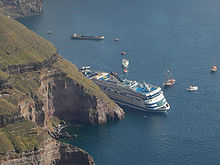 Sinking of Sea Diamond, 2007
Sinking of Sea Diamond, 2007The expansion of tourism in recent years has resulted in the growth of the economy and population. Santorini was ranked the world's top island by many magazines and travel sites, including the Travel+Leisure Magazine,[34] the BBC,[35] as well as the US News.[36] An estimated 2 million tourists visit annually.[37] In recent years, Santorini has been emphasising sustainable development and the promotion of special forms of tourism, the organization of major events such as conferences and sport activities.
The island's pumice quarries have been closed since 1986, in order to preserve the caldera. In 2007, the cruise ship MS Sea Diamond ran aground and sank inside the caldera. As of 2019, Santorini is a particular draw for Asian couples who come to Santorini to have pre-wedding photos taken against the backdrop of the island's landscape.[38]







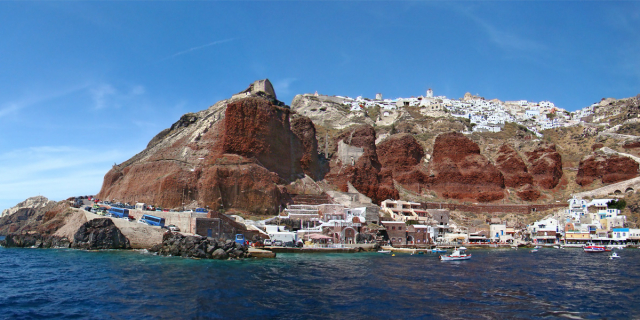








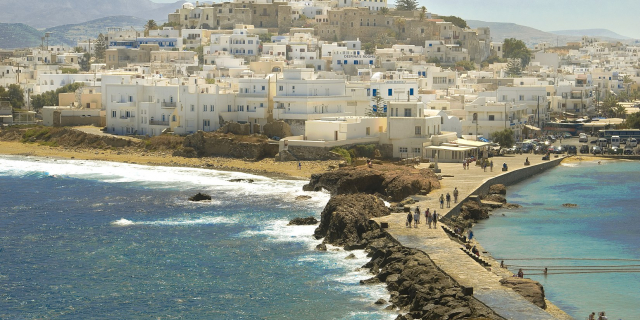

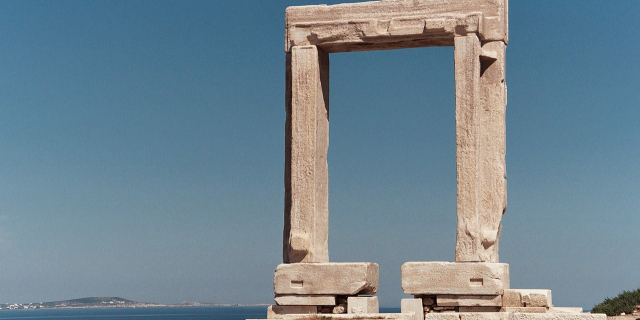

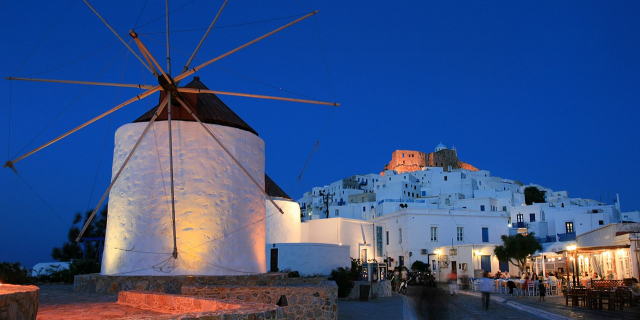
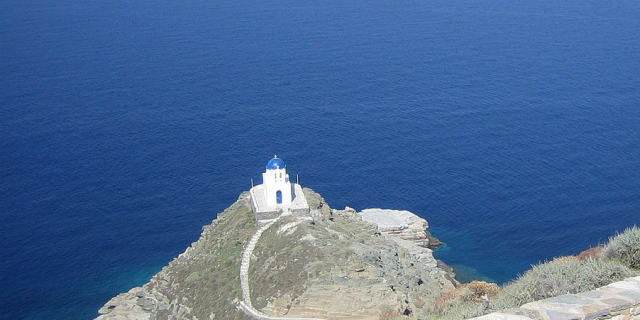

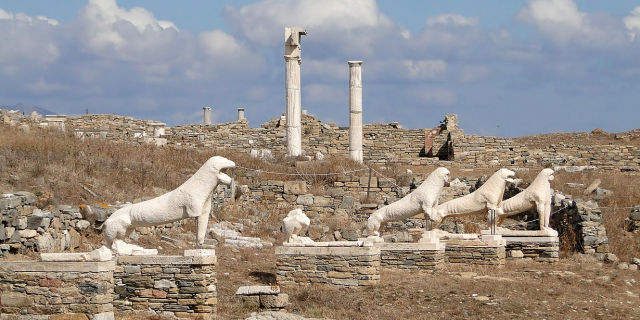





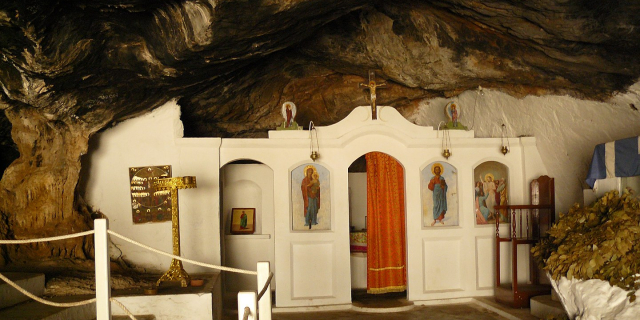

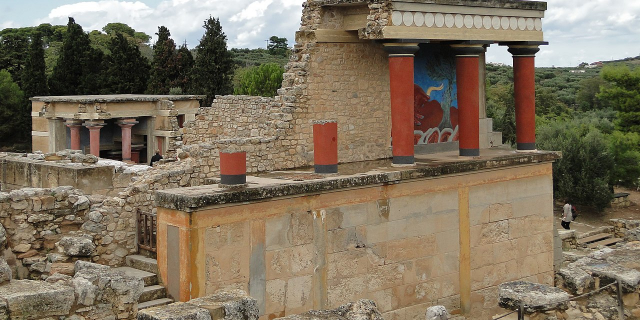
Add new comment